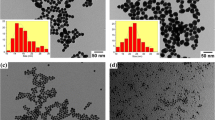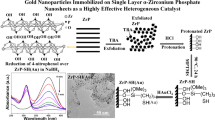Abstract
Separation of homogeneous catalyst from the reaction mixture is a crucial and difficult process in any catalytic process. To address this issue, a new class of multifunctional catalyst in the form of film was developed using a facile approach to enjoy the advantages of homogeneous catalyst with the versatility of heterogeneous catalyst. To achieve the same, methionine-capped gold nanodots (AuNDs) were self-assembled on a cationic polyelectrolyte modified glass plate for the catalytic reduction of nitro functional groups in the presence of olefinic double bond at mild conditions. Separation of this reusable catalytic film from the reaction mixture is very simple and advantageous when compared to the currently available and conventional catalytic systems. Kinetics of nitro reduction was monitored using absorption spectroscopy and the product formation was confirmed by \(^{1}\hbox {H}\) and \(^{13}\hbox {C}\,\hbox {NMR}\) analyses. Prepared AuNDs catalyst was characterized using UV-Vis spectroscopy, X-ray photoelectron spectroscopy (XPS), X-ray diffraction (XRD), high-resolution transmission electron microscopy (HRTEM), cyclic voltammetry and atomic force microscopy (AFM) techniques.
Graphical Abstract
SYNOPSIS Colloidal gold nanoparticles are efficient catalysts for organic reactions. But the removal of homogeneous gold colloids from the reaction mixture is very difficult. To address this issue, gold nanodots were synthesized and self-assembled over polyelectrolyte film to form catalytic plates. Removal of these reusable catalytic plates from the reaction mixture is facile.









Similar content being viewed by others
References
Thomas J M and Thomas W J 1997 (Eds.) In Principles and Practice of Heterogeneous Catalysis (VCH: Weinheim)
An K and Somorjai G A 2015 Nanocatalysis I: synthesis of metal and bimetallic nanoparticles and porous oxides and their catalytic reaction studies Catal. Lett. 145 233
Daniel M-C and Astruc D 2004 Gold nanoparticles: assembly, supramolecular chemistry, quantum-size-related properties, and applications toward biology, catalysis, and nanotechnology Chem. Rev. 104 293
Tamiolakis I, Fountoulaki S, Vordos N, Lykakisb I N and Armatas G S 2013 Mesoporous Au–\(\text{TiO}_{2}\) Nanoparticle assemblies as efficient catalysts for the chemoselective reduction of nitrocompounds J. Mater. Chem. A 1 14311
Rathore P S, Patidar R, Shripathic T and Thakore S 2015 Magnetically separable core–shell iron oxide@nickel nanoparticles as high-performance recyclable catalysts for chemoselective reduction of nitroaromatics Catal. Sci. Technol. 5 286
Guerrero E, Munoz-Marquez M A, Garcıa M A, Crespo P, Fernandez-Pinel E, Hernando A and Fernandez A 2008 Surface plasmon resonance and magnetism of thiol-capped gold nanoparticles Nanotechnology 19 175701
Templeton A C, Chen S, Gross S M and Murray R W 1999 Water-soluble isolable gold clusters protected by tiopronin and coenzyme A monolayers Langmuir 15 66
Bourg M-C, Badia A and Lennox R B 2000 Gold-sulfur bonding in 2D and 3D self-assembled monolayers: XPS characterization J. Phys. Chem. B 104 6562
Gaur S, Miller J T, Stellwagen D, Sanampudi A, Kumar C S S R and Spivey J J 2012 Synthesis, characterization, and testing of supported Au catalysts prepared from atomically-tailored \(\text{ Au }_{38}\)(SC12H25)24 clusters Phys. Chem. Chem. Phys. 14 1627
Angelova P, Solel, E, Parvari G, Turchanin A, Botoshansky M, Gölzhauser A and Keinan E 2013 Chemisorbed monolayers of corannulene penta-thioethers on gold Langmuir 29 2217
Tseng R J, Baker C O, Shedd B, Huang J, Kaner R B, Ouyang J and Yang Y 2007 Charge transfer effect in the polyaniline-gold nanoparticle memory system Appl. Phys. Lett. 90 053101
Qiu L, Liu F, Zhao L, Yang W and Yao J 2006 Evidence of a unique electron donor-acceptor property for platinum nanoparticles as studied by XPS Langmuir 22 4480
Viswanathan P and Ramaraj R 2017 Preparation of polyelectrolyte-stabilized silver nanoparticles for catalytic applications Polym. Int. 66 342
Tian N, Zhou Z-Y, Sun S-G, Ding Y and Wang Z L 2007 Synthesis of tetrahexahedral platinum nanocrystals with high-index facets and high electro-oxidation activity Science 316 732
Viswanathan P and Ramaraj R 2016 Polyelectrolyte assisted synthesis and enhanced catalysis of silver nanoparticles: electrocatalytic reduction of hydrogen peroxide and catalytic reduction of 4-nitroaniline J. Mol. Catal. A Chem. 424 128
Henglein A and Lilie J 1981 Storage of electrons in aqueous solution: the rates of chemical charging and discharging the colloidal silver microelectrode J. Am. Chem. Soc. 103 1059
Chiu C-Y, Chung P-J, Lao K-U, Liao C-W and Huang M H 2012 Facet-dependent catalytic activity of gold nanocubes, octahedra, and rhombic dodecahedra toward 4-nitroaniline reduction J. Phys. Chem. C 116 23757
Zhu C, Han L, Hu P and Dong S 2012 In situ loading of well-dispersed gold nanoparticles on two-dimensional graphene oxide/\(\text{ SiO }_{2}\) composite nanosheets and their catalytic properties Nanoscale 4 1641
Fenger R, Fertitta E, Kirmse H, Thunemann A F and Rademann K 2012 Size dependent catalysis with CTAB-stabilized gold nanoparticles Phys. Chem. Chem. Phys. 14 9343
Seo E, Kim J, Hong Y, Kim Y S, Lee D and Kim B S 2013 Double hydrophilic block copolymer templated Au nanoparticles with enhanced catalytic activity toward nitroarene reduction J. Phys. Chem. C 117 11686
Li M and Chen G 2013 Revisiting catalytic model reaction P-nitrophenol/\(\text{ NaBH }_{4}\) using metallic nanoparticles coated on polymeric spheres Nanoscale 5 11919
Biondi I, Laurenczy G and Dyson P J 2011 Synthesis of gold nanoparticle catalysts based on a new water-soluble ionic polymer Inorg. Chem. 50 8038
Esumi K, Miyamoto K and Yoshimura T 2003 Morphological change of gold–dendrimer nanocomposites by laser irradiation J. Colloid Interface Sci. 268 501
Hayakawa K, Yoshimura T and Esumi K 2003 Preparation of gold-dendrimer nanocomposites by laser irradiation and their catalytic reduction of 4-nitrophenol Langmuir 19 5517
Wang X, Long Y, Wang Q, Zhang H, Huang X, Zhu R, Teng P, Liang L and Zheng H Z 2013 Reduced state carbon dots as both reductant and stabilizer for the synthesis of gold nanoparticles Carbon 64 499
Fan C M, Zhang L F, Wang S S, Wang D H, Lu L Q and Xu A W 2012 Novel \(\text{ CeO }_{2}\) yolk–shell structures loaded with tiny Au nanoparticles for superior catalytic reduction of \(p\)-nitrophenol Nanoscale 4 6835
Xiao C, Chen S, Zhang L, Zhou S and Wu W 2012 One-pot synthesis of responsive catalytic Au@PVP hybrid nanogels Chem. Commun. 48 11751
Huang T, Meng F and Qi L 2009 Facile synthesis and one-dimensional assembly of cyclodextrin-capped gold nanoparticles and their applications in catalysis and surface-enhanced raman scattering J. Phys. Chem. C 113 13636
Han J, Li L and Guo R 2010 Novel approach to controllable synthesis of gold nanoparticles supported on polyaniline nanofibers Macromolecules 43 10636
Kelly S M and Lipshutz B H 2014 Chemoselective reductions of nitroaromatics in water at room temperature Org. Lett. 16 98
Dotzauer D M, Bhattacharjee S, Wen Y and Bruening M 2009 Nanoparticle-containing membranes for the catalytic reduction of nitroaromatic compounds Langmuir 25 1865
Blaser H-U, Siegrist U and Steiner H 2001 In Aromatic Nitro Compounds: Fine Chemicals through Heterogeneous Catalysis (Wiley-VCH: Weinheim) p. 389
Acknowledgements
RR acknowledges the financial support received from the CSIR-Emeritus Scientist Scheme, New Delhi. PV is the recipient of Senior Research Fellowship under UGC-BSR scheme.
Author information
Authors and Affiliations
Corresponding author
Electronic supplementary material
Below is the link to the electronic supplementary material.
Rights and permissions
About this article
Cite this article
Viswanathan, P., Ramaraj, R. Gold nanodots self-assembled polyelectrolyte film as reusable catalyst for reduction of nitroaromatics. J Chem Sci 130, 4 (2018). https://doi.org/10.1007/s12039-017-1405-0
Received:
Revised:
Accepted:
Published:
DOI: https://doi.org/10.1007/s12039-017-1405-0




